If you don’t ask, you don’t receive. And if you run a business, you don’t have to ask for feedback all the time – you can just collect it on your own.
Instead of waiting for (potential) customers to tell you how they feel about your brand, you can be proactive and measure brand sentiment. With a sentiment analysis tool, you have all the information you need at your fingertips.
Today, we’ll show you how to measure brand sentiment, why it’s important, and how Prowly can help.
- What is brand sentiment?
- What is a good brand sentiment?
- Why is brand sentiment analysis important?
- How to measure brand sentiment in four steps
- How to analyze brand sentiment with Prowly
- How to improve brand sentiment
What is brand sentiment?
Brand sentiment is how an individual or a group of people feel about your brand, product, services, and overall offer.
Brand sentiment can be classified into three groups: positive sentiment, negative sentiment and neutral sentiment.
Why is brand sentiment analysis important?
Brand sentiment analysis allows businesses to track the overall health of their brand and take action if things go south.
By measuring and analyzing brand sentiment, you can examine how the general public perceives your brand and use this information to direct your sales, marketing and product efforts.
Media monitoring, which includes brand sentiment analysis, is helpful because it allows for a better understanding of public opinion and perception.
✅ It helps you track mentions in real time without the manual work.
✅ Helps you spot potential crises in time to react.
✅ Gives you a full breakdown of the most important analytics: where people mention you, why and what their sentiment is.
What is a good brand sentiment?
As mentioned, there are three types of brand sentiment: positive, negative and neutral.
If you use a sentiment analysis tool, you’ll quickly figure out that the situation is rarely black or white. While there are some truly amazing brands out in the world, none of them has a fully positive brand sentiment.
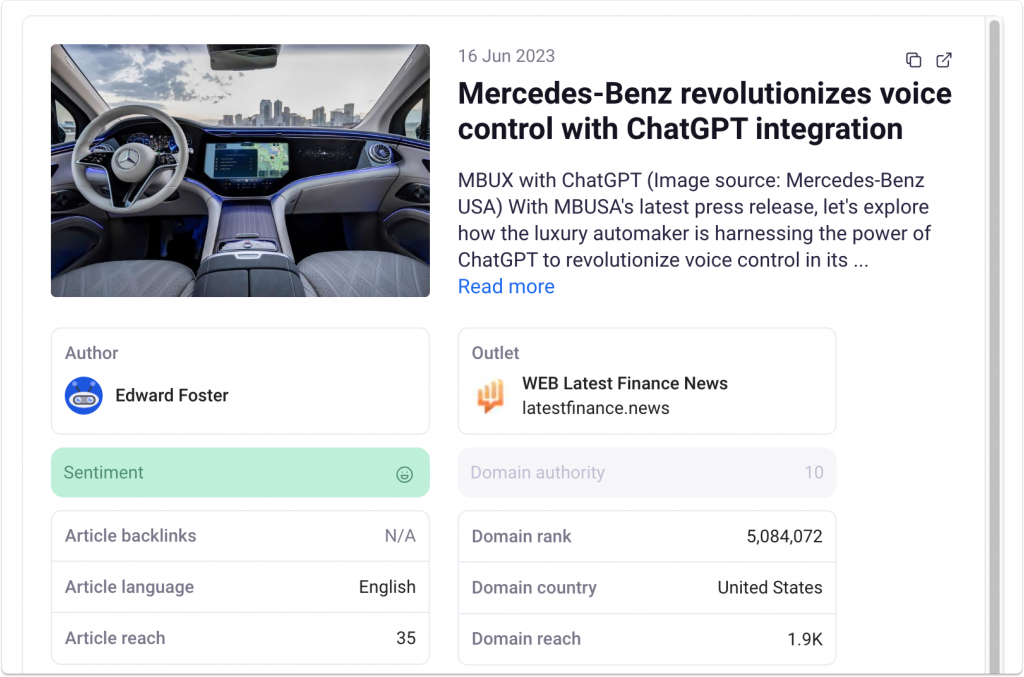
It rarely happens that a brand has entirely positive or negative sentiment. In reality, it’s a mixed bag.
Positive brand sentiment is a result of dedicated and hard work, quality products and services, superior customer service, and consistently good work over time.
As such, you should strive to maintain mostly positive brand sentiment and keep an eye on your negative mentions over time.
Why is brand sentiment analysis important?
Brand sentiment is important for every brand, no matter how big or small. Here are several reasons why you need to analyze brand sentiment. Keep track of your overall brand health.
How the general public feels about your brand is important to your reputation, share of voice, and in the end, revenue.
- PR crisis mitigation. One negative situation can lead to an avalanche of bad comments and light your social network profiles on fire. When you measure brand sentiment, ideally with real-time notifications, you’ll immediately know if a crisis is looming.
- Improved customer satisfaction. You’ll know exactly what customers love about your brand and what makes their blood boil. By measuring brand sentiment, you know what to improve in your product, customer service, marketing and more.
- Brand equity. You can measure and improve the overall state of your brand: how likable and recognizable it is and how loyal your customers are to you.
Most importantly for all of the factors above: you can see the context in which your brand is presented, rather than looking at brand mentions in isolation. Sentiment metrics show how our narrative resonates with the opinions of the broader public.
Grab your free trial of Prowly today and start measuring brand sentiment on autopilot!
How to measure brand sentiment in four steps?
There is no ideal tool or set of tools that are good for every business. However, the beauty of digital marketing is that you can quickly test and iterate the ways in which you measure brand sentiment. Here are some of our tips for success.
#1 Benchmark against competitors
Measuring your share of voice means comparing your own brand sentiment to that of your competitors. And with modern sentiment analysis tools such as Prowly, it’s a piece of cake.
For example, the article below mentions both – OpenAI’s ChatGPT and its competitor – Bard from Google.
It also reflects the sentiment of the mention in the context of people fearing AI’s machine learning models and data leaks.
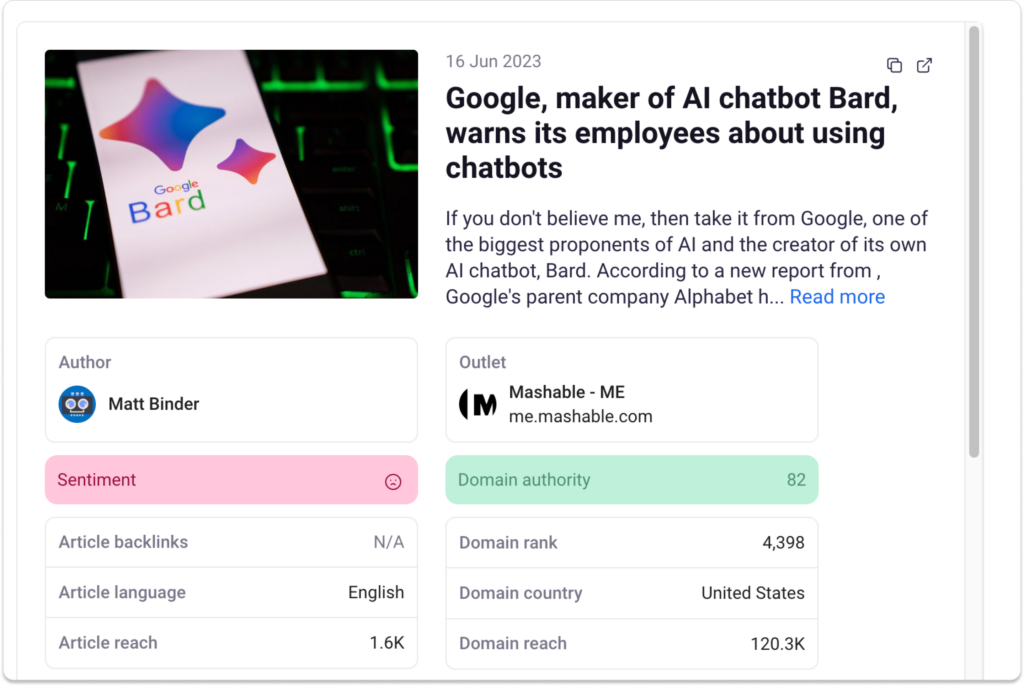
Simply load up your competitors’ brand terms alongside yours and you can see the sentiment analysis for all brands compared over time.
Speaking of ChatGPT – here are the best prompts for PR to save you time on creating yours. And if you’re using it to prepare a press release or pitch drafts, you can also try Prowly’s AI features and have all your tasks in one place.
#2 Test often
Brand analysis tools can give you the equipment you need to track brand sentiment, but it is up to you to find the methods that work best for your specific brand.
You should test out different channels and networks (social media, websites, forums, Reddit, etc.), in order to find out which ones bring the most value to your sentiment analysis report.
Services such as Prowly that allow you to track brand and other media mentions, will give you a quick analysis of your top sources and mentions.
For example, you may get the most mentions from social media, but the most valuable ones may come from blogs.
🗝 The takeaway is: don’t just set up a brand name or a term and track it and call it a day. If you receive many mentions on a daily basis, you’ll need to come up with a strategy to filter the ones that provide the most valuable insights.
#3 Double-check the mention context
When benchmarking your own brand sentiment against your competitors, make sure to double-check for context. Despite becoming more sophisticated with each year, sentiment analysis tools can get it wrong sometimes.
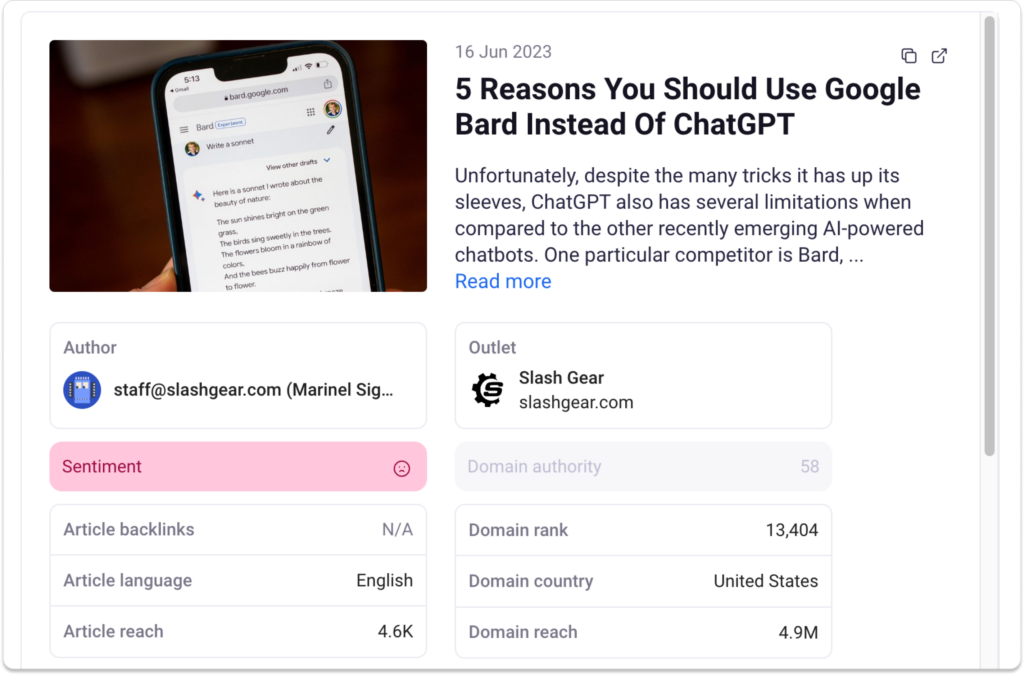
For example, as shown in the screenshots, the overall sentiment of an article can be positive while mentioning your brand in a negative context. Unfortunately, most tools mistakenly flag this as positive sentiment.
- So this article is not about OpenAI but about Google as a brand.
- However, it mentions OpenAI as a bad example, so the sentiment shown by Prowly is correct.

#4 Combine data science with a human touch
Most sentiment analysis tools are amazing at picking up your brand mentions in real-time. However, the AI and machine learning algorithms that these tools use are still not perfect.
This means that these tools can often mistakenly assign the wrong sentiment to a brand mention.
This is why you can never fully trust the results. Besides collecting brand sentiments from social media platforms and websites by using these tools, make sure you have a human being to analyze them time and time again.
This not only ensures a more accurate reading of brand sentiment but also creates a better-rounded image of your customer.
And if you’re already using Media Monitoring, but you’re not sure how to ethically introduce AI to your PR agency, read this guide we prepared, along with our PR professionals.
Sign up for your free trial of Prowly to how people feel about your brand starting from this moment.
How to analyze brand sentiment with Prowly
PR professionals need a full suite of tools to do their jobs well, from crafting a perfect press release with AI to pitching it to the right media, to analyzing media mentions and more. Prowly has it all in one place, including sentiment analysis – and here’s exactly how it works.
→ Interested in brand monitoring solutions? Dive into the “13 Best Brand Monitoring Tools for PR Managers” for in-depth insights.
Use media monitoring to track brand sentiment and mentions
Media monitoring means tracking the mentions of your brand online: from websites, forums, social media platforms, and more.
Each time someone mentions your brand (or target term), Prowly notifies you. You also get a summary and breakdown of your mentions and sentiment of the articles where your brand was placed.
In short it works like this:
- the Media Monitoring tool tracks brand mentions,
- each brand mention is evaluated,
- each article with the brand mention can have positive/negative/neutral sentiment.
Prowly’s AI identifies the context, sentiment and over 15 other properties of each press hit.
What’s key – you can track brand mentions across social media channels, such as Facebook and X (Twitter). You can keep up to date whenever your brand is mentioned in a discussion, or in a post/tweet, and learn the sentiment in real time.
That means you can monitor your client’s brand online presence 24/7, across the web, including social media, blogs, forums, and websites. You can also break down this data, e.g. by country, to interpret it better, just like in the image above.
Set email alerts to stay in the know
Of course, you can keep Prowly open and watch as the mentions roll in – but you don’t have to.
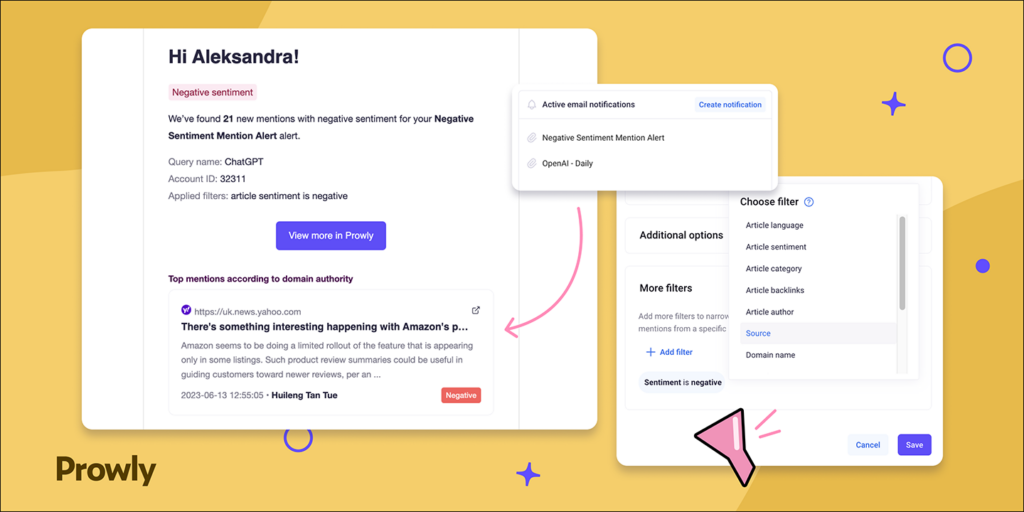
Within the monitoring dashboard, you can set email alerts for brand mentions and set rules for when you want to receive them.
- Even more importantly, you can set what kind of mentions you want to be notified about.
- You can use email alerts to prevent crises if a large number of negative mentions come in at once.
- It’s also useful for tracking trends for PR campaigns and monitoring your competitors’ PR activities.
Customize how often you want these emails to come in and what kind of conditions need to be met in order to warrant an email.
For example, you can only receive emails about negative mentions from a certain author or source.
Ready to get started?
Add brand sentiment to your PR reports with a few clicks
Since Prowly lets you create PR reports, you can add brand sentiment to those reports with just a few clicks, thanks to our automated features.
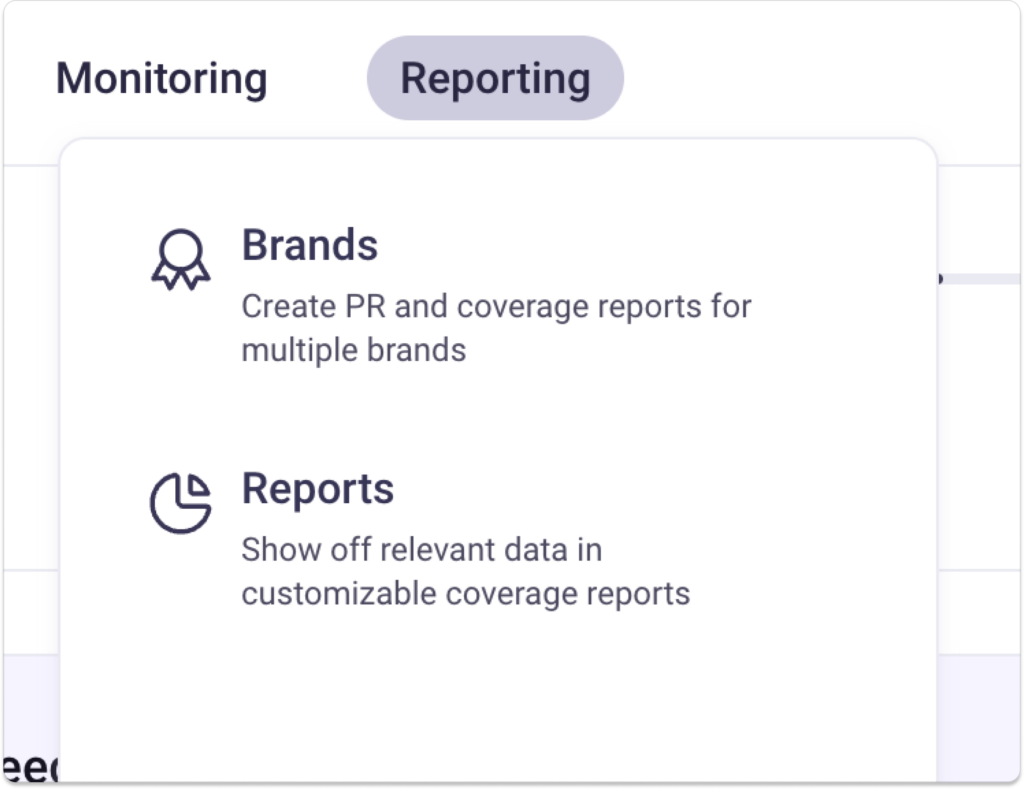
You can choose any mentions that you find relevant to your PR goals. Then adjust the report to your brand by setting up custom branding and adding your own commentary to the brand sentiment analysis.
How to improve brand sentiment?
Improving your brand’s sentiment is not a one-off task that you can do once and forget about entirely. Improving your brand reputation takes considerable effort and ongoing work.
Here are a few methods you can employ to improve your overall brand sentiment:
1️⃣ Monitor your brand sentiment religiously.
Use tools such as Prowly to monitor every mention of your brand so you can better understand how customers feel about you.
2️⃣ Invest time and money in customer service and support.
If your product or service is focused on quality, customer support can be the key differentiator for your brand’s reputation.
3️⃣ Track your competitors and their mentions.
Many times, their brand sentiment metrics will show you exactly what (and what not) to do.
4️⃣ Create a PR strategy.
Once you’ve done enough sentiment analysis measurement, you’ll be able to see what needs work and how a good PR strategy can fill those gaps.
5️⃣ Respond to customer comments.
Whether it’s social media, websites or review platforms, use every opportunity to respond to your customers. Not responding can quickly turn a neutral sentiment into a negative one.
Conclusions
Tracking your brand sentiment is one of the easiest ways to measure the overall health of your brand. And thanks to modern brand sentiment tracking tools, you can track brand mentions without the tedious, manual work.
Watch the recordings of PR Episodes 2024 to explore how to measure your PR efforts effectively. Industry experts provided valuable insights into PR metrics and actionable strategies for improvement.
Ready to find out how your customers feel about you on social media and beyond? Grab your free trial of Prowly today and supercharge your PR efforts with brand analysis.

